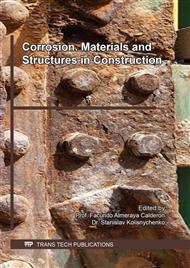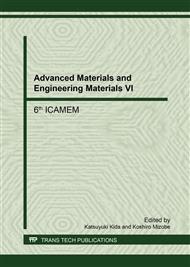[1]
Paul D, DC Stray Current in Rail Transit Systems and Cathodic Protection, IEEE Industry Applications Magazine, 22(2016): 8-13.
DOI: 10.1109/mias.2015.2481754
Google Scholar
[2]
Susanto A, Koleva D A, Copuroglu O, et al, Mechanical, electrical and microstructural properties of cement-based materials in conditions of current flow, Journal of Advanced Concrete Technology, 11(2013): 119-134.
DOI: 10.3151/jact.11.119
Google Scholar
[3]
Yang L X, Di R G, Liu S B, Study on the monitoring and control system of stray current in urban mass transit, Journal of railway engineering society, 23(2006): 19-21.
Google Scholar
[4]
Li Y G, Li J P and Yuan H M, Study on the real-time monitoring system of laboratory simulation of metro stray current, CHINA RAIL WAY SCIENCE, 26(2005): 119-122.
Google Scholar
[5]
Zhang Q H and Zhu H H, Metro and Light Rail, Beijing, China Communications Press, (2002).
Google Scholar
[6]
Darowicki K and Zakowski K, A New Time-frequency Detection Method of Stray Current Field Interference on Metal Structures, Corrosion Science, 46(2004): 1061-1070.
DOI: 10.1016/j.corsci.2003.09.007
Google Scholar
[7]
Geng J, The research on the deteriorated mechanism of reinforced concrete in stray currents and chloride ion coexisted corrosion environment, Wuhan University of Technology, (2008).
Google Scholar
[8]
Huang W X, Yin S H , Li T F, et al, Effect of stray current on the dissoluble corrosion of Guangzhou metro engineering concrete by accelerated test, Concrete, (2008).
Google Scholar
[9]
Li J Y, Cao J G, Research and application of hydraulic concrete durability, China Electric Power Press, (2004).
Google Scholar
[10]
Huang W X. Research on the anti-corrosion durability of concrete structure of GZ metro under multiple environmental factors, South China University of Technology, (2011).
Google Scholar
[11]
Zhou X J, Gao B, Experimental study on metro stray current corrosion of rebars in reinforced concrete, WEST-CHINA EXPLORATION ENGINEERING, (1999).
Google Scholar
[12]
Wu X, Study on deterioration characteristics of reinforced concrete in the persence of stray current and chloride ion, Wuhan University of Technology, (2008).
Google Scholar
[13]
Wu Q S, Research of steel corrosion in concrete under the coupling actions of stray currents and chloride ion, East China Jiaotong University, (2011).
Google Scholar
[14]
Chen M C, Wang K, Wu Q S, et al, Experimental investigation on corrosion of reinforced concrete due to coupled stray currents and chloride ions, Journal of the China Railway Society, 35(2013): 112-117.
Google Scholar
[15]
Zhang X Q, Xu F, Wang S G et al, Influence of stray current on chloride ion transport mechanism in underground structure concrete, Concrete, (2016): 75-78.
Google Scholar
[16]
Guo L P, Yang B, Chen B, et al, Coupling effects of stray current and chloride ion on corrosion resistance of fiber reinforced mortar, Journal of Water Resources and Architectural Engineering, 14(2016): 11-17.
Google Scholar
[17]
Zhang E M, The anti-erosion performance of metro concrete under the effect of bending load and stray current coupled with corrosive medium, South China University of Technology, (2011).
Google Scholar
[18]
Han K, Xu F, Wang S G, et al, Influence of the coupled effect of stray current and sulfate upon chloride diffusing into concrete of underground structures, Concrete, (2016): 45-48.
Google Scholar
[19]
Qin Z, Research on corrosion fatigue damage structure under stray current corrosion and its service life prediction, East China Jiaotong University, (2013).
Google Scholar
[20]
Chen M C, Qin Z, Wang K, et al, Study on fatigue stiffness damage of reinforced concrete beams under coupling effect of stray current and chloride, HIGH SPEED RAILWAY TECHNOLOGY, (2012): 25-29.
Google Scholar
[21]
Chen X J, Ouyang Y L, Qian W X, et al, Influences of stray current on corrosion behaviors of reinforcing steel bar in concrete placed in different environments, Hydro-Science and Engineering, 35(2014): 33-37.
Google Scholar
[22]
Du Y J, Ma S J and et al, The prediction on enduring life span of anti-spreading electricity current for concrete in the subway engineering, Journal of Water Resources and Architectural Engineering, (2003): 7-9.
Google Scholar
[23]
Lin A L and Zhou X J, Experimental study on metro stray current corrosion of rebars in reinforced concrete and the influence of corrosion on concrete strength, Modern Tunnelling Technology, (1999).
Google Scholar
[24]
Du Y J, Study on the durability of the subway concrete structure and service life prediction, Hohai University, (2005).
Google Scholar
[25]
Du Y J, Li Y T, The restraining function of active aggregate on stray electricity current in subway concrete, Concrete, (2005).
Google Scholar
[26]
Chen Z, Dai W, He H A, et al, Restraint Effect of Concrete Admixed with Fly Ash on Subway Stray Currents, China Municipal Engineering, (2002).
Google Scholar
[27]
An X, Shi C, He F, et al, AC impedance characteristics of ternary cementitious materials, Journal of the Chinese Ceramic Society, 40(2012): 1059-1066.
Google Scholar
[28]
Wu H F, He H L and Li B Z, Influence of fly ash/ground slag on stray current corrosion resistance performance of concrete for subway, Coal Ash, (2011).
Google Scholar
[29]
Cheng F, Gao X B, Qian C X, et al, Effect of mineral admixtures on the performance of concrete against stray current, CHINA CONCRETE AND CEMENT PRODUCTS, (2011): 13-16.
Google Scholar
[30]
Ding H T, The research on the subway concrete of high impedance and impervious, Wuhan University of Technology, (2008).
Google Scholar
[31]
Geng J, Ding Q, Sun B, et al, Microstructural characteristics of concrete with high impedance and impermeability, Journal of the Chinese Ceramic Society, (2010).
Google Scholar
[32]
Hu S G, Geng J and Ding Q J, The characters of cement hardened paste with mineral admixtures binding chloride ion under the condition of stray current interfering, Journal of Huazhong University of Science & Technology, 36(2008): 32-34.
Google Scholar
[33]
He H Z, Shi M Land Chen Z Y, Inhibitory effect of fly ash on stray current in subway, CHINA CONCRETE AND CEMENT PRODUCTS, (2001): 21-23.
Google Scholar
[34]
Lin J, Tang H, High-impedance concrete for use in metro engineering, Journal of Building Materials, (2001).
Google Scholar
[35]
GONI S, ANDRADE C, PAGE C L, Corrosion behaviour of steel in high alumina cement mortar sample: Effect of chloride, Cement and Concrete Research, 21(1991): 635- 646.
DOI: 10.1016/0008-8846(91)90114-w
Google Scholar
[36]
SANJUAN M A, Effect of curing temperature on corrosion of steel bars embedded in calcium aluminate mortars exposed to chloride solutions, Corrosion Science, (1999): 335-350.
DOI: 10.1016/s0010-938x(98)00075-4
Google Scholar
[37]
Ding Q J, Wu X and Geng J, Experimental study of binding capability of chloride ion under stray current in cement hardened paste admixed with fly ash, Journal of Building Materials, (2008): 80-83.
Google Scholar
[38]
Zhang L J, Zheng Z, Colloid and Interface Chemistry, South China University of Technology Press, (2006).
Google Scholar



